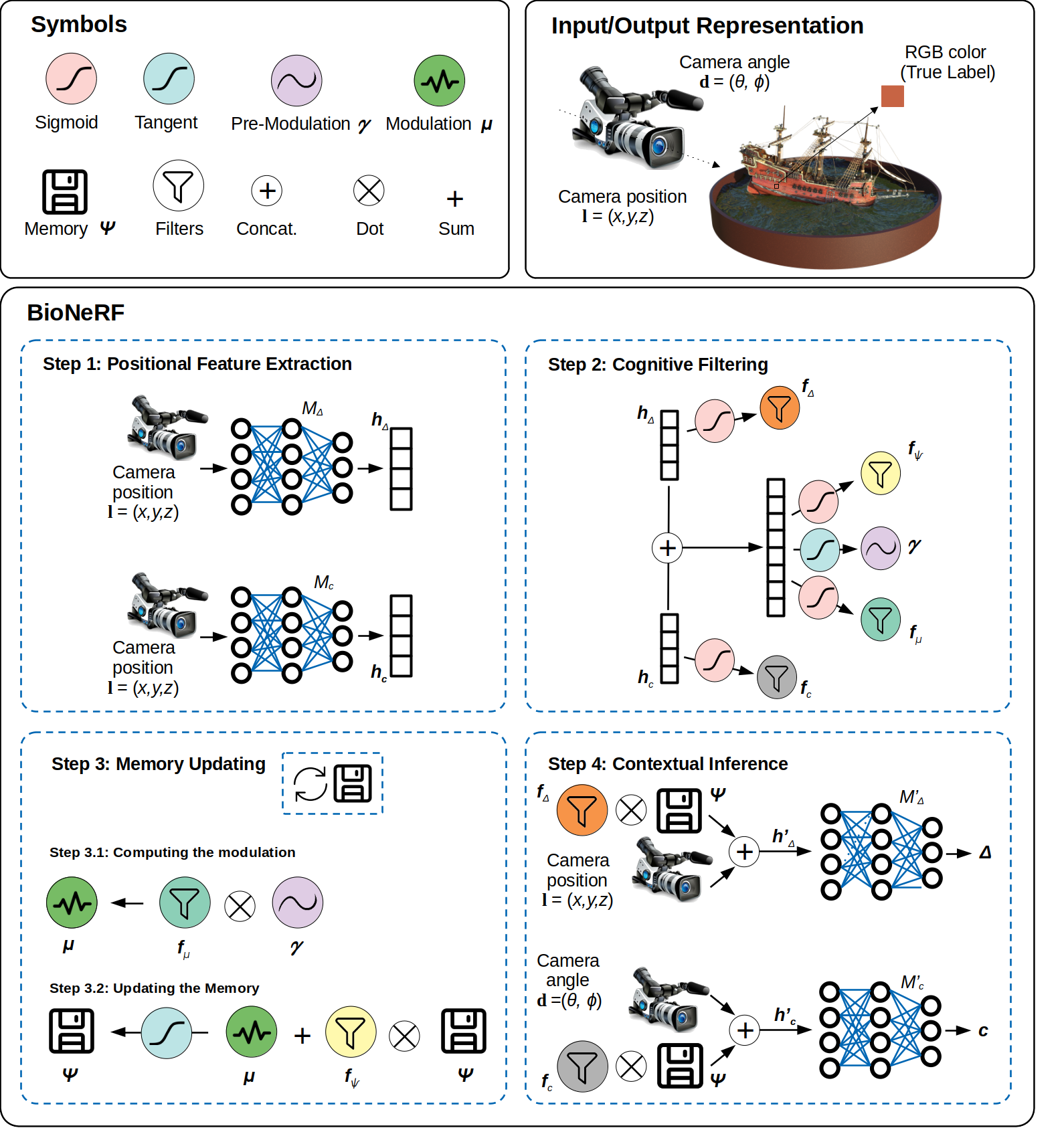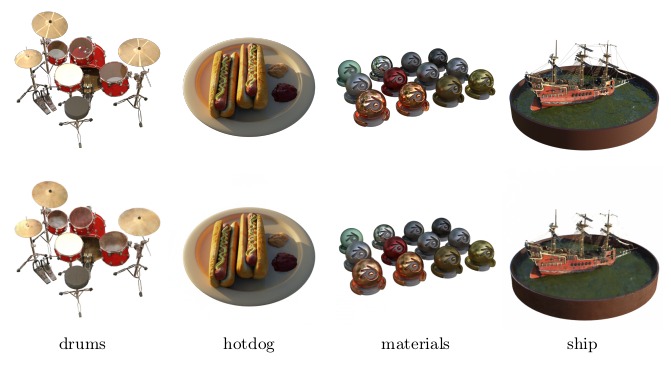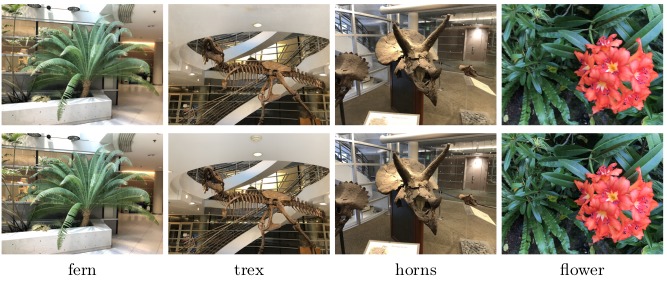This is the official implementation of BioNeRF.
BioNeRF (Biologically Plausible Neural Radiance Fields) extends NeRF by implementing a cognitive-inspired mechanism that fuses inputs from multiple sources into a memory-like structure, thus improving the storing capacity and extracting more intrinsic and correlated information. BioNeRF also mimics a behavior observed in pyramidal cells concerning contextual information, in which the memory is provided as the context and combined with the inputs of two subsequent blocks of dense layers, one responsible for producing the volumetric densities and the other the colors used to render the novel view. The method outperformed recent approaches and achieves state-of-the-art results for synthesizing novel views of complex scenes. Here are some videos generated by this repository (pre-trained models are provided below):
Code release for:
BioNeRF: Biologically Plausible Neural Radiance Fields
Leandro A. Passos, Douglas Rodrigues, Danilo Jodas, Kelton A. P. Costa, Ahsan Adeel, João Paulo Papa
📰 Paper

This code is based on a PyTorch implementation of NeRF.
git clone https://github.com/Leandropassosjr/BioNeRF.git
cd BioNeRF
pip install -r requirements.txt
Dependencies (click to expand)
- numpy
- torch
- torchvision
- imageio
- imageio
- matplotlib
- configargparse
- tensorboard
- tqdm
- opencv-python
- torchmetrics
The LLFF data loader requires ImageMagick.
Download synthetic Blender and LLFF scenes from here. Place the downloaded dataset according to the following directory structure:
├── configs
│ ├── ...
│
├── data
│ ├── nerf_llff_data
│ │ └── fern
│ │ └── flower # downloaded llff dataset
│ │ └── horns # downloaded llff dataset
| | └── ...
| ├── nerf_synthetic
| | └── lego
| | └── ship # downloaded synthetic dataset
| | └── ...
To train a 400x400 ship scene on BioNeRF:
python run_bionerf.py --config configs/ship.txt
After training you can find the following video at logs/blender_paper_ship/blender_paper_ship_spiral_400000_rgb.mp4.
To train BioNeRF on different datasets:
python run_bionerf.py --config configs/{DATASET}.txt
replace {DATASET} with trex | horns | flower | fortress | lego | etc.
To test BioNeRF trained on different datasets:
python run_bionerf.py --config configs/{DATASET}.txt --render_only --render_test --generate_samples
replace {DATASET} with trex | horns | flower | fortress | lego | etc.
You can download the pre-trained models here. Place the downloaded directory in ./logs in order to test it later. See the following directory structure for an example:
├── logs
│ ├── fern_test
│ ├── flower_test # downloaded logs
│ ├── trex_test # downloaded logs
Here is an overview pipeline for BioNeRF, we will walk through each component in this guide.
The first step consists of feeding two neural models simultaneously, namely
This step performs a series of operations, called filters, that work on the embeddings coming from the previous step. There are four filters this step derives: density, color, memory, and modulation.
Updating the memory requires the implementation of a mechanism capable of obliterating trivial information, which is performed using the memory filter (Step 3.1 in the figure). Fist, one needs to compute a signal modulation
This step is responsible for adding contextual information to BioNeRF. Two new embeddings are generated, i.e.,
Blender (synthetic)
| drums | materials | ficus | ship | mic | chair | lego | hotdog | AVG | |
|---|---|---|---|---|---|---|---|---|---|
| PSNR | 25.66 | 29.74 | 29.56 | 29.57 | 33.38 | 34.63 | 31.82 | 37.23 | 31.45 |
| SSIM | 0.927 | 0.957 | 0.965 | 0.874 | 0.978 | 0.977 | 0.963 | 0.980 | 0.953 |
| LPIPS | 0.047 | 0.018 | 0.017 | 0.068 | 0.018 | 0.011 | 0.016 | 0.010 | 0.026 |
Ground-truth (top) and synthetic view (bottom) images generated by BioNeRF regarding four Realistic Blender dataset’s scenes.
LLFF (real)
| Fern | Flower | Fortress | Horns | Leaves | Orchids | Room | T-Rex | AVG | |
|---|---|---|---|---|---|---|---|---|---|
| PSNR | 25.17 | 27.89 | 32.34 | 27.99 | 22.23 | 20.80 | 30.75 | 27.56 | 27.01 |
| SSIM | 0.837 | 0.873 | 0.914 | 0.882 | 0.796 | 0.714 | 0.911 | 0.911 | 0.861 |
| LPIPS | 0.093 | 0.055 | 0.025 | 0.070 | 0.103 | 0.122 | 0.029 | 0.044 | 0.068 |
Ground-truth (top) and synthetic view (bottom) images generated by BioNeRF regarding four LLFF dataset’s scenes.
@article{passos2024bionerf,
title={BioNeRF: Biologically Plausible Neural Radiance Fields for View Synthesis},
author={Passos, Leandro A and Rodrigues, Douglas and Jodas, Danilo and Costa, Kelton AP, Adeel, Ahsan and Papa, Jo{\~a}o Paulo},
journal={arXiv preprint arXiv:2402.07310},
year={2024}
}





